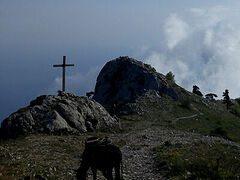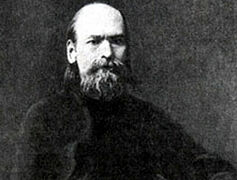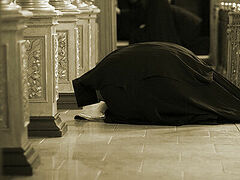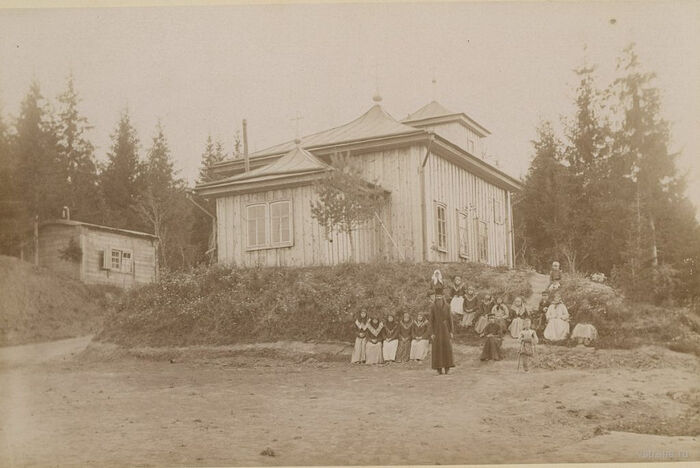 St. Stephan in front of the church of the Fileika Skete
St. Stephan in front of the church of the Fileika Skete
Spiritual teaching and pastoral care
In 1874, elementary schools began to crop up. As an experienced teacher, Simeon was chosen to teach at one of them. Having received recognition, Simeon began publishing his writings (which were the fruit of many years of labor), extracts from Sacred Scripture, and reflections. Around 1874, his first book, On Drunkenness, was published. Simeon’s works began to be read in parish churches after Matins so the free time before Liturgy wouldn’t be lost in idle conversations.
The books made their way to Bishop Apollos of Vyatka and Sloboda, and he liked them very much. He proposed that Simeon become a monk. Simeon hesitated for a whole year, but finally accepted his offer. On February 23, 1877, in Holy Cross Monastery in Sloboda, he was tonsured into monasticism with the name Stephan in honor of St. Stephan of Great Perm, the enlightener of the Vyatichi. A few days later, he was ordained a hierodeacon, and soon afterwards, a hieromonk. However, Fr. Stephan couldn’t serve in Sloboda due to poor health, and after seven months, he was released into retirement. He returned to Fileika and continued living in his hermitage in the forest.
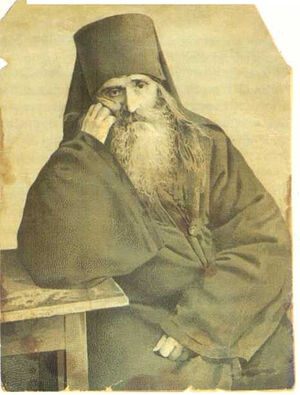 Hieromonk Stephan Fr. Stephan continued writing and publishing his books. They were in high demand and were widely distributed amongst the people. In addition, remembering his debt to Fr. Ieronym, he published his works for St. Panteleimon’s Monastery on Mt. Athos as well. It should be noted that the monastery itself later published individual works of the saint at least until 1900. It can be said that all of Vyatka knew the name of Fr. Stephan of Fileika already by the early 1880s.
Hieromonk Stephan Fr. Stephan continued writing and publishing his books. They were in high demand and were widely distributed amongst the people. In addition, remembering his debt to Fr. Ieronym, he published his works for St. Panteleimon’s Monastery on Mt. Athos as well. It should be noted that the monastery itself later published individual works of the saint at least until 1900. It can be said that all of Vyatka knew the name of Fr. Stephan of Fileika already by the early 1880s.
In 1883, Fr. Stephan took his books to the Raifa Monastery in the Kazan Governorate, where Bishop Pavel of Kazan was at that time. Having met the famous author, he invited him to stay in the monastery and arrange a skete, but Bishop Apollos of Vyatka didn’t release him. Then Fr. Stephan himself proposed to build a monastery on the site of his skete. Vladyka gave his consent, but as subsequent history shows, he didn’t secure his blessing with a decree.
Disciples began to gather around Fr. Stephan. Many wanted to stay in the new monastery, but Batiushka didn’t accept even close to everyone, being very careful. At first he took only six people to his skete. It’s likely that one of them was the future ascetic of piety Hierodeacon Tikhon (Kozhevnikov). Over time, in addition to the church, up to thirteen small and large wooden houses, a flour mill, and the once famous Fileika ponds were organized. More than fifty people were fed there daily, including widows with young children from nearby villages. Fr. Stephan built huts and bought horses and cows for many of the peasants, and paid taxes for some of them.
In 1885, after the death of Bishop Apollos, during an analysis of the diocesan documentation of the reposed bishop, the employees of the Vyatka consistory couldn’t find a decree on the establishment of the skete in Fileika. On March 9, 1886, Fr. Stephan was sent to the Vyatka Dormition Monastery “with a prohibition on serving” for his “unauthorized” construction of a prayer house and the arrangement of a skete, for the duration of the proceedings. As a result, Fr. Stephan’s detention dragged on for several years. It should be noted that the close friendship between St. Stephan and Mitrophan Kuzmich—the future Vyatka saint Venerable Mathew Yaransky, who became the most famous spiritual successor of the Elder Stephan—developed at this time.
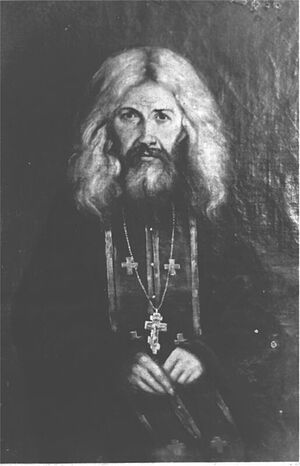 St. Matthew Yaransky In 1888, Fr. Stephan’s nephew, the merchant Peter Ivanovich Kurteev, having decided to take the monastic tonsure, probably not without the support of his uncle started petitioning for the opening of a new monastery. The matter came to the Chief Procurator of the Holy Synod K. P. Pobedonostsev, who delivered the report directly to the sovereign himself, who then confirmed the decision to open the new St. Alexander Nevsky Monastery near the village of Fileika. Thus, in 1888, Fr. Stephan’s skete was converted into a monastery.
St. Matthew Yaransky In 1888, Fr. Stephan’s nephew, the merchant Peter Ivanovich Kurteev, having decided to take the monastic tonsure, probably not without the support of his uncle started petitioning for the opening of a new monastery. The matter came to the Chief Procurator of the Holy Synod K. P. Pobedonostsev, who delivered the report directly to the sovereign himself, who then confirmed the decision to open the new St. Alexander Nevsky Monastery near the village of Fileika. Thus, in 1888, Fr. Stephan’s skete was converted into a monastery.
The Elder himself was actively involved in the building up of the monastery, and on December 4, 1889, his ban on serving was removed.
Fr. Stephan became seriously ill during Great Lent in 1890 and began to weaken. The ban had broken the Elder’s weak health. The Lord revealed to him the day of his repose—August 15. Fr. Stephan told one of his friends about this date two weeks before his repose. Also, on July 10, Fr. Stephan gave a book of his writings to a visiting resident of Kronstadt, the retired petty officer Vasily Bakin, for Fr. John of Kronstadt, entreating his prayers—not for his health, but for his repose.
Shortly before his death, Fr. Stephan accepted the schema with the same name, after which he communed of the Holy Mysteries of Christ every day until his death. There are testimonies that Fr. Stephan bore the burden of his illness without complaining and with good humor. A day before his death, Fr. Ippolit Mishkin from the city of Urzhuma came to say goodbye. Fr. Ippolit asked:
“You’re not afraid of death?”
“Oh, yes! Batiushka, I can’t even wait for it to come. I don’t know where it’s gotten to. I so want to die!”
The next day, August 15/28, the feast of the Dormition of the Most Holy Theotokos, in the sixty-first year of his life, Fr. Stephan peacefully departed to the Lord. He was buried by the altar of the main monastery church. Thousands of pilgrims came to bid farewell to the Elder. Fr. Stephan’s last will and testament was a request to the brethren to sing his favorite hymn, “God Is With Us,” at his grave.
Posthumous veneration and canonization
The official opening of the monastery was held a month after the repose of Fr. Stephan, on September 16, which gathered, according to eyewitness testimony, at least 10,000 people. Created with love, the monastery became a fortress of paternal faith. In 1904, the construction of the main church—the Holy Trinity Cathedral—began.
When the atheists came to power, the monastery was closed and all the buildings were destroyed, but the pilgrimage to St. Stephan’s grave never stopped even in the most terrible years of persecution. The God-fighting authorities made every effort to erase the memory of the ascetic from the people’s hearts. Thus, during the years of the Khruschev persecution, they planned to plant an orchard on the site of Fr. Stephan’s grave. But in the end, under the cover of night, the grave was simply bulldozed. In the morning, the nuns collected the scattered remains they found and buried them in the Fileika Cemetery.
In 1998, the icon from St. Stephan’s cell—the wonderworking icon of the Great Martyr and Healer Panteleimon—was miraculously found. A cache was found in it, with a cruciform reliquary inside and a note which read: “In this cross are the holy relics of the Healer St. Panteleimon and the holy New Martyr Euthemius the Athonite. Mt. Athos, December 6, 1863, abbot of the Monastery of the Annunciation, Schemamonk Partheny.”
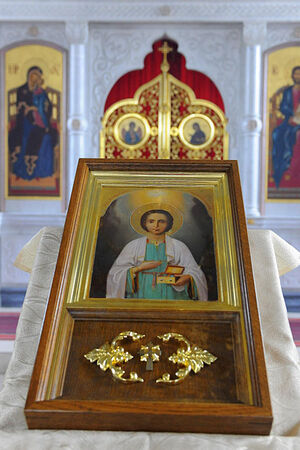 The icon from St. Stephan’s cell On October 29, 2001, on the basis of the unceasing veneration of the ascetic and the miracles worked by his prayers, Patriarch Alexei II of Moscow and All Russia blessed the glorification of St. Stephan as a locally venerated saint of the Vyatka Diocese. The glorification was held on July 14, 2002, in the Dormition Cathedral of the St. Tryphon Monastery by Archbishop Chrysanth of Vyatka and Sloboda, concelebrated by Archbishop Alexander of Kostroma and Galich, Archbishop Evgeny of Verey, and Bishop Tikhon of Arkhangelsk and Kholmogorsk.
The icon from St. Stephan’s cell On October 29, 2001, on the basis of the unceasing veneration of the ascetic and the miracles worked by his prayers, Patriarch Alexei II of Moscow and All Russia blessed the glorification of St. Stephan as a locally venerated saint of the Vyatka Diocese. The glorification was held on July 14, 2002, in the Dormition Cathedral of the St. Tryphon Monastery by Archbishop Chrysanth of Vyatka and Sloboda, concelebrated by Archbishop Alexander of Kostroma and Galich, Archbishop Evgeny of Verey, and Bishop Tikhon of Arkhangelsk and Kholmogorsk.
An icon of the saint was painted, a troparion, kontakion, and short life were composed, and a chapel was built and consecrated in honor of St. Stephan at Fileika Cemetery. Since 2002, a procession to the chapel and presumed grave of St. Stephan has been held annually.
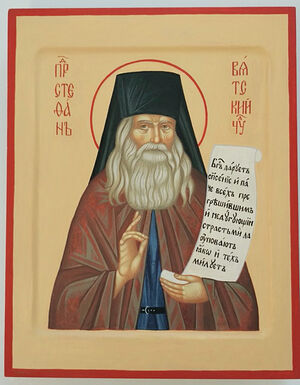 Icon of St. Stephan of Fileika, by Hieromonk Makary (Floresa) It should be noted that St. Stephan was for some time a spiritual child of Fr. Ieronym and undoubtedly absorbed a living spiritual experience that can be received only in personal communication with a spiritual father. Subsequently, St. Stephan himself raised many spiritual children, the brightest of which we can say was St. Matthew the Wonderworker of Yaransk (1855-1927). He, in turn, left behind a spiritual successor, Igumen Joasaph (Sychev) (1889-1961), and he—Archimandrite Gabriel (Kislitsin) (1929-2020), who reposed in 2020 at the age of 90. Until his very death, people from all over Russia came to him for his spiritual counsel and blessing. Thus, the continuity of spiritual experience, the significant link of which is the person of Fr. Stephan, has been preserved for two centuries.
Icon of St. Stephan of Fileika, by Hieromonk Makary (Floresa) It should be noted that St. Stephan was for some time a spiritual child of Fr. Ieronym and undoubtedly absorbed a living spiritual experience that can be received only in personal communication with a spiritual father. Subsequently, St. Stephan himself raised many spiritual children, the brightest of which we can say was St. Matthew the Wonderworker of Yaransk (1855-1927). He, in turn, left behind a spiritual successor, Igumen Joasaph (Sychev) (1889-1961), and he—Archimandrite Gabriel (Kislitsin) (1929-2020), who reposed in 2020 at the age of 90. Until his very death, people from all over Russia came to him for his spiritual counsel and blessing. Thus, the continuity of spiritual experience, the significant link of which is the person of Fr. Stephan, has been preserved for two centuries.

